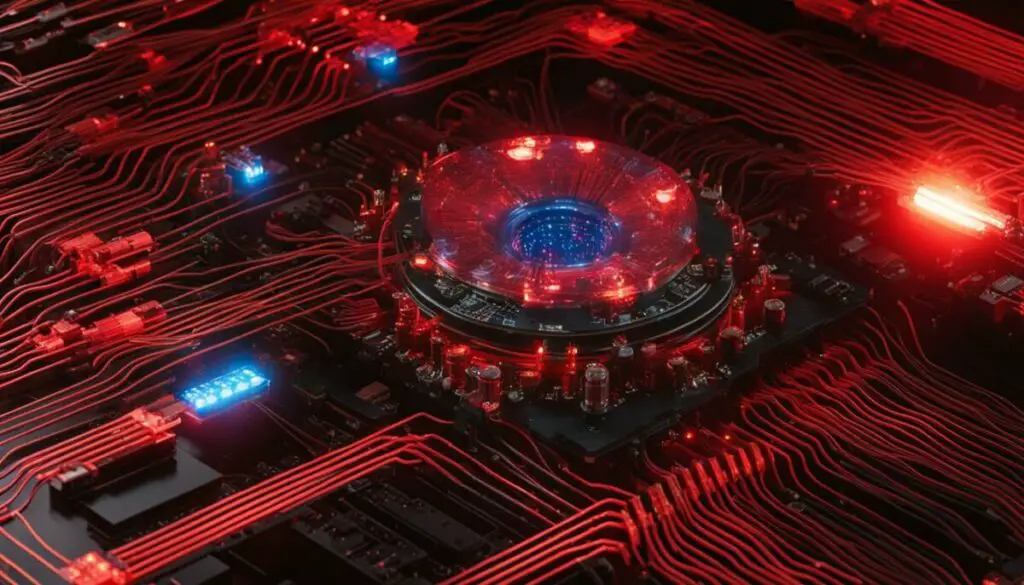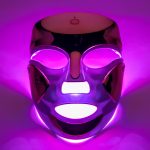Last Updated on 6 months by Francis
Welcome to the world of infrared LED technology! Have you ever wondered how those invisible signals are transmitted through your TV remote control or how security cameras capture clear images in the dark? It’s all thanks to the incredible workings of infrared LED technology. In this article, we will explore the fascinating world of infrared LED and unravel the mystery behind its operation, explaining how it works and its applications in various industries.
Contents
Key Takeaways:
- Infrared LED technology emits light in the infrared spectrum, which is invisible to the human eye.
- It works by passing an electric current through a semiconductor material, causing the release of infrared photons.
- Infrared LEDs are widely used in applications such as remote controls, security cameras, and medical devices.
- Benefits of infrared LED technology include energy efficiency, longer lifespan, and compact size.
- Infrared LED technology has promising future developments in communication and healthcare.
Understanding the Technology Behind Infrared LED

Infrared LED technology is based on the properties of specific semiconductor materials, such as gallium arsenide or indium gallium arsenide. These materials have a bandgap that allows for the emission of infrared light. When a forward voltage is applied to the LED, electrons and holes recombine in the semiconductor, releasing energy in the form of infrared photons. The wavelength of the emitted light depends on the bandgap energy of the material.
Infrared LEDs are typically designed to emit light in specific wavelength ranges, such as near-infrared (NIR) or short-wavelength infrared (SWIR), to suit different applications. This ability to control the emitted wavelength enables the customization of infrared LED technology for specific needs, whether it’s in remote controls, security cameras, night vision devices, or medical devices.
To understand the basics of infrared LED operation, it’s important to recognize how the injection of current into the LED results in the recombination of electrons and holes, leading to the emission of infrared light. This working mechanism forms the foundation of infrared LED technology and its various applications across industries.
Infrared LED Technology in Action
Let’s take a closer look at how infrared LED technology functions in real-world applications:
Remote Control: Infrared LEDs are commonly used in remote controls, where the emitted infrared light is received by a sensor on the device being controlled. When a button is pressed on the remote control, the LED emits a specific infrared signal that corresponds to the desired action, such as changing the channel or adjusting the volume.
Night Vision Cameras: Infrared LEDs play a crucial role in night vision cameras. These cameras use infrared light to illuminate a scene, making it visible in low-light or complete darkness. The infrared LEDs emit light that is invisible to the human eye but can be detected by the camera’s sensor, allowing for clear and detailed images to be captured.
Medical Devices: Infrared LEDs are widely used in medical devices such as pulse oximeters, which measure oxygen saturation in the blood. By emitting infrared light into the body and detecting the reflected light, these devices can accurately determine the oxygen levels, providing valuable insights for medical professionals.
From remote controls to night vision cameras and medical devices, understanding the technology behind infrared LEDs sheds light on their practical applications and the role they play in enhancing various industries.
The Working Mechanism of Infrared LED
The working mechanism of an infrared LED involves several key components. When a current is applied, electrons and holes are injected into the active region of the LED. These charge carriers recombine, generating photons. The wavelength of the emitted light depends on the energy bandgap of the semiconductor material. The photons are emitted in the form of infrared light, which can be detected by specialized devices such as infrared cameras or sensors. Infrared LEDs can be designed to emit light in a specific direction or in a wide-angle beam, depending on the desired application.
The Injection and Recombination Process
When a forward voltage is applied to an infrared LED, electrons are injected from the n-type region into the p-type region, while holes are injected from the p-type region into the n-type region. These injected charge carriers migrate to the active region of the LED where they recombine. The recombination process involves an electron falling from a higher energy level to a lower energy level, releasing energy in the form of a photon. The energy difference between the initial and final energy levels determines the wavelength of the emitted light, which in the case of infrared LEDs is in the infrared range.
Controlling the Emission Direction
Infrared LEDs can be designed to emit light in a specific direction or in a wide-angle beam. This is achieved through the use of various packaging techniques and optical elements. For directional emission, infrared LEDs can be encapsulated in a lens that focuses the emitted light in a narrow beam. This is useful in applications where precise illumination is required, such as in infrared remote controls. On the other hand, for wide-angle emission, the LED can be designed with a larger emitting surface or a diffuser can be used to scatter the light in a broader pattern. This is beneficial in applications like security cameras where a wide coverage area is desired.
| Advantages of Infrared LED Technology | |
|---|---|
| Energy Efficiency | Infrared LEDs consume less power compared to other light sources, making them cost-effective and environmentally friendly. |
| Long Lifespan | Infrared LEDs have a longer lifespan than traditional lighting technologies, reducing the need for frequent replacements. |
| Compact Size | The small size of infrared LEDs allows for easy integration into various devices and systems. |
| Minimal Heat Emission | Infrared LEDs emit minimal heat, making them suitable for applications where heat generation is a concern. |
| Enhanced Privacy | The emitted infrared light is invisible to the human eye, providing enhanced security and privacy. |
Infrared LED Applications: Illuminating the Possibilities

Infrared LED technology has found its way into a wide range of applications across various industries. Let’s explore some of the diverse uses of this innovative technology.
Applications in Consumer Electronics
In the realm of consumer electronics, infrared LEDs have become a staple component in remote controls. Whether you’re changing channels on your TV or adjusting the temperature on your air conditioner, these tiny yet powerful LEDs enable seamless communication between devices. Additionally, infrared LEDs are utilized in proximity sensors found in smartphones, allowing for touchless interaction with your device.
Enhancing Security and Surveillance
Infrared LEDs play a crucial role in the security and surveillance industry, enabling effective night vision capabilities. By emitting invisible infrared light, cameras equipped with these LEDs can capture clear images in low-light conditions. This technology is widely used in surveillance cameras for both residential and commercial purposes, ensuring enhanced security and peace of mind.
Advancements in Biomedical Applications
The application of infrared LED technology in the biomedical field has opened up new avenues for diagnostics and treatment. Infrared LEDs are integral components in devices such as pulse oximeters, which measure oxygen saturation in the blood. Furthermore, they are being investigated for their potential in wound healing and pain management, offering non-invasive and targeted therapeutic solutions.
| Industry | Application |
|---|---|
| Consumer Electronics | Remote controls, proximity sensors |
| Security and Surveillance | Night vision cameras |
| Biomedical | Pulse oximeters, wound healing, pain management |
As the versatility of infrared LED technology continues to unfold, we can anticipate further advancements and innovative applications in the years to come. From consumer electronics to healthcare and beyond, the possibilities are truly enlightening.
Benefits of Infrared LED Technology

When it comes to lighting technology, infrared LED offers numerous advantages that make it stand out from traditional lighting sources. Let’s explore some of the key benefits of infrared LED:
- Energy Efficiency: Infrared LEDs consume less power compared to other light sources, making them highly energy efficient. This not only helps reduce electricity costs but also minimizes their environmental impact.
- Long Lifespan: Infrared LEDs have an extended lifespan, far surpassing traditional lighting options. This means fewer replacements and lower maintenance costs in the long run.
- Compact Size: The compact size of infrared LEDs allows for easy integration into various devices and systems. This makes them versatile and suitable for a wide range of applications.
- Minimal Heat Generation: Infrared LEDs emit minimal heat, which makes them ideal for applications where heat generation needs to be controlled or minimized. This is particularly important in sensitive environments where excess heat can cause damage or affect performance.
- Enhanced Security and Privacy: Infrared LEDs emit light in the infrared spectrum, which is invisible to the human eye. This makes them perfect for applications where enhanced security and privacy are required.
These benefits make infrared LED technology a preferred choice in various industries, such as consumer electronics, security and surveillance, healthcare, and communication. With its energy efficiency, long lifespan, compact size, and enhanced privacy, infrared LED continues to offer innovative solutions for lighting needs.
Future Developments in Infrared LED Technology

The field of infrared LED technology is constantly evolving, with ongoing research and development efforts aimed at pushing the boundaries of efficiency and expanding the potential applications of this innovative technology. Advancements in infrared LED technology have the potential to revolutionize various industries, from healthcare to communication.
One area of focus for future developments in infrared LED technology is increasing the power levels at which these LEDs operate. Higher power levels would enable improved performance and increased range in applications such as long-range communication and LiDAR systems. This could have significant implications for industries that rely on wireless communication and detection capabilities.
Another area of research is expanding the wavelength range of infrared LEDs. By developing LEDs that can emit light at different wavelengths, scientists and engineers can unlock new possibilities in medical imaging, spectroscopy, and other applications. This could lead to advancements in healthcare diagnostics and treatment, as well as improvements in industrial and scientific processes.
The integration of infrared LEDs with other technologies is another exciting area of future development. Researchers are exploring how infrared LEDs can be combined with artificial intelligence and machine learning to enhance the functionality and capabilities of infrared devices. This opens up possibilities for more intelligent and autonomous systems that can adapt and optimize their performance based on real-time data.
In summary, future developments in infrared LED technology hold great promise for improving efficiency, expanding wavelength ranges, and exploring new applications. From advancements in power levels and wavelength ranges to the integration of infrared LEDs with other technologies, the possibilities are vast. As research continues, we can expect to see even more exciting advancements and innovative applications of this remarkable technology.
Advancements in Infrared LED Technology for Healthcare

Infrared LED technology has made significant advancements in the healthcare field, revolutionizing various applications. The use of infrared LEDs in medical imaging techniques, such as endoscopy, has greatly improved the quality of images captured inside the body. With their ability to emit infrared light, these LEDs provide precise illumination, enabling healthcare professionals to diagnose and treat patients more effectively.
One key area where infrared LED technology is being explored is in photodynamic therapy. This innovative treatment method utilizes light to activate photosensitive drugs, which can destroy cancer cells. Infrared LEDs are used to deliver the light required for the therapy, offering a targeted and precise approach to cancer treatment.
Infrared LED technology also holds promise in the field of wound healing. Studies have shown that certain wavelengths of infrared light can stimulate tissue repair and reduce inflammation, promoting faster healing of wounds. Researchers are investigating the use of infrared LED devices to optimize this healing process and improve patient outcomes.
Advancements in Infrared LED Technology for Healthcare
“Infrared LED technology has the potential to revolutionize healthcare, enabling more precise diagnosis, targeted treatments, and improved patient outcomes.”
In conclusion, advancements in infrared LED technology are paving the way for significant improvements in healthcare. From medical imaging to cancer treatment and wound healing, these advancements offer new possibilities for more precise diagnosis, targeted therapies, and enhanced patient care. As research and development in this field continue, we can expect to see even greater advancements in infrared LED technology that will further transform the healthcare industry.
Exploring the Potential of Infrared LED Technology in Communication
Infrared LED technology has the potential to revolutionize communication systems by providing an efficient and secure method for short-range data transmission. With the increasing demand for high-speed communication, infrared LEDs offer a promising solution that can carry large amounts of data and is immune to interference from radio frequency signals. This makes them particularly suitable for environments where radio frequency communication is restricted, such as hospitals, aircraft, and industrial facilities.
Infrared communication systems utilizing LED technology have several advantages. Firstly, the use of infrared light ensures a higher level of security as it is invisible to the human eye, making it difficult for unauthorized individuals to intercept the transmitted data. Additionally, infrared LEDs consume less power compared to traditional communication methods, resulting in energy savings and reduced operational costs. These LEDs also have a longer lifespan and require less maintenance, providing further cost benefits.
“Infrared LED technology opens up new possibilities for data transmission, enabling faster transfer rates and improved network security.”
Researchers are currently exploring the use of infrared LEDs in Li-Fi (Light Fidelity) technology, which utilizes light signals for wireless communication. Li-Fi has the potential to achieve significantly faster data transfer rates compared to traditional Wi-Fi, making it ideal for applications that require high-speed communication, such as video streaming and data-intensive tasks. Moreover, the use of infrared LEDs in Li-Fi ensures a more secure transmission, as the light signals are confined within a shorter range and are less susceptible to interception.
Table: Comparing Infrared LED Communication with Traditional Communication Methods
| Communication Method | Infrared LED Communication | Traditional Communication |
|---|---|---|
| Security | High level of security as infrared light is invisible to the human eye | Potential vulnerability to unauthorized interception |
| Power Consumption | Low power consumption, resulting in energy savings | Higher power consumption |
| Lifespan | Longer lifespan and less maintenance required | Shorter lifespan and regular maintenance required |
| Data Transfer Rates | Potential for faster data transfer rates | Limited data transfer rates |
In conclusion, the potential of infrared LED technology in communication is vast. With its advantages in security, power consumption, and lifespan, infrared LEDs offer an attractive solution for short-range data transmission. Ongoing advancements in this technology, coupled with the emerging field of Li-Fi, are expected to drive further innovation and open up new possibilities for faster and more secure communication.
Conclusion
Infrared LED technology has revolutionized various industries with its wide range of applications and numerous benefits. By harnessing the properties of specific semiconductor materials, infrared LEDs emit light in the infrared spectrum, making them ideal for applications such as remote controls, security cameras, and medical devices.
One of the major advantages of infrared LED technology is its energy efficiency, consuming less power and reducing operational costs. Additionally, these LEDs have a longer lifespan and emit minimal heat, making them suitable for various devices and systems. The invisible infrared light emitted by these LEDs also enhances security and privacy.
As ongoing research and development efforts continue, the future of infrared LED technology looks promising. Advancements in efficiency, expanded wavelength ranges, and integration with other technologies will further drive innovation in healthcare, communication, and other fields. With these advancements, infrared LED technology is poised to play an even more significant role in shaping the future.
FAQ
How does infrared LED work?
Infrared LED works by passing an electric current through a semiconductor material, causing the electrons to release energy in the form of infrared photons.
What is the working mechanism of an infrared LED?
When a current is applied, electrons and holes recombine in the semiconductor, generating photons in the form of infrared light.
What are the applications of infrared LED technology?
Infrared LED technology is used in remote controls, security cameras, night vision devices, medical devices, and more.
What are the benefits of infrared LED technology?
Infrared LED technology offers energy efficiency, longer lifespan, compact size, minimal heat generation, and enhanced security and privacy.
What are the future developments in infrared LED technology?
Ongoing research aims to improve efficiency, expand wavelength ranges, and explore new applications for infrared LED technology.
How is infrared LED technology advancing in the healthcare industry?
Infrared LED technology is being used in medical imaging, photodynamic therapy, wound healing, pain management, and wearable devices for healthcare monitoring.
What is the potential of infrared LED technology in communication?
Infrared LED technology can provide efficient and secure short-range communication, with researchers exploring its use in Li-Fi technology for faster data transfer rates.









